Roundhouse
Initially, the mill probably did not have a roundhouse and was open to the elements. We think that the roundhouse was added in the 19th century when the trestle was replaced. The trestle was replaced once again in 1980.
The post
The post is original and was a single oak tree. It is 6.6 metres in height. It is suspended above the ground, and the tensile load is taken by the cross-trees which pass under the post. Four wedges between the post and cross-trees prevent lateral movement of the bottom of the post.
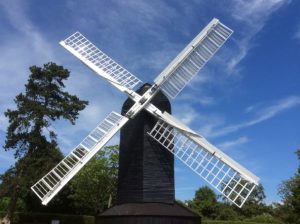 The sails, or sweeps, are fixed to the end of the windshaft by means of a cast-iron canister, or poll end. The stocks are wedged into the canister and the whips are bolted to the stocks. The overall diameter is 58 feet (18 metres) and the timber weighs around 3 tons.
The sails, or sweeps, are fixed to the end of the windshaft by means of a cast-iron canister, or poll end. The stocks are wedged into the canister and the whips are bolted to the stocks. The overall diameter is 58 feet (18 metres) and the timber weighs around 3 tons.
There is a pair of Common sails – a framework covered with canvas – and a pair of Spring Shutter sails – a series of wooden boards actuated by a long shutter bar and held by a large leaf spring.
Ideally, the sails need to turn at around ten revolutions per minute to achieve good grinding.
Winding the Mill. The sails must face the wind to turn effectively and prevent damage to the mill. The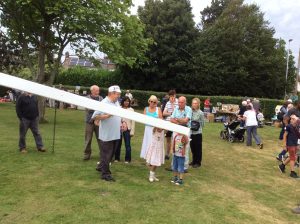 early design of this mill means that this is done by lifting the steps which anchor the mill, by means of an oak lever called a talthur.
early design of this mill means that this is done by lifting the steps which anchor the mill, by means of an oak lever called a talthur.
Spout floor
This is where the miller would normally work and where the flour comes down from the stones and the wire machine above. On this floor can be seen:
The crown tree. The top of the post connects to the crown tree via a cast iron bearing called a Samson Head, and it supports the whole weight of the mill. The crown tree is solid oak and weighs 2 tons. A new one was installed in 1982 and the old one is still beside the gatehouse.
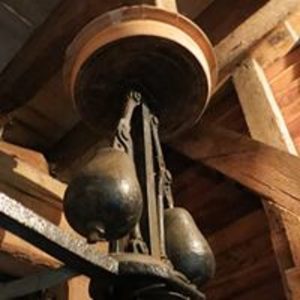
The tentering gear. This is operated from the spout floor, allowing the miller to manually alter the gap between the stones if necessary. Originally a system of levers and screw adjustment, it can also be operated by a rope. At a later time, stone governors were installed to automatically adjust the gap as the wind force changes.
Stone Floor
On this floor are two pairs of stones driven by the windshaft in a “head and tail” configuration. The breast stones (which are in use today) are of Derbyshire millstone grit, quarried as whole stones in the Peak District. They are more suited to larger grains and animal feed, such as peas and beans.
The tail stones are French Burr stones made of pieces of hard quartz mined near Paris, set in plaster of Paris and bound with iron bands. They were used to grind finer flour. These stones are no longer used because the tail wheel is too fragile to withstand operation.
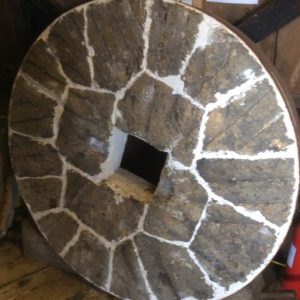
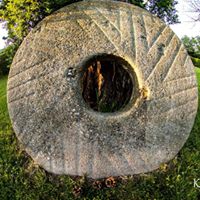
Dressing the stones is the term used for cutting the radial grooves in the grinding surface of the stones. The runner stone is cut to allow a wider gap between the stones near the eye to form a swallow into which the grain is drawn.
The brake wheel was made by the Friends of the mill over a period of eight years from start to installation. It is 3 metres in diameter and made from three kinds of wood: oak for the spokes, elm for the rim and apple for the 136 teeth. It is braked by means of a brake lever.
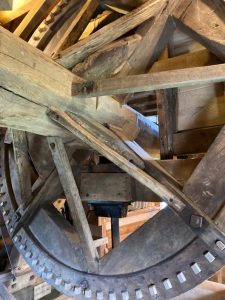
The tail wheel is a compass arm wheel 2.5 metres in diameter. It is very old and possibly original.
Wire machine. This is a grader driven by the tail wheel. Flour falls into 3 chutes with sacks attached on the spout floor below.
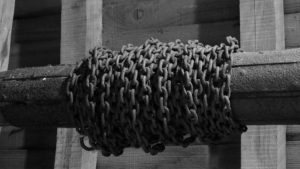
Sack hoists can be seen above the trap doors beside the brake wheel, and in the roof. They are driven by friction drives off the tail wheel. Unusually there are two sack hoists.
Output. The maximum output today is approximately 50 kilos an hour in a good steady wind. We use Canadian and English grain to produce a good quality wholemeal flour.
The windshaft is rare as it is a single oak tree holding the two large wheels. It is inclined and it rests on a neck bearing. The end protrudes out to the front and the sails are fitted to it through the sweep stocks.
The Granary
Our granary (C18?) was acquired from a farm in East Grinstead in 1993. The mushroom-shaped steddal stones and the inward folding steps prevent vermin from entering.